Management Accounting System Report: Unilever Case Study Analysis
VerifiedAdded on 2023/01/18
|13
|3533
|57
Report
AI Summary
This comprehensive report delves into the management accounting system employed by Unilever, a transnational business. It begins with an introduction to management accounting (MA) and the role of management accountants within an enterprise, specifically focusing on Unilever. The report then explores the scope of MA, its relationship with various business functions like marketing and HRM, and contrasts it with financial accounting, highlighting overlaps and differences. Subsequent sections analyze different cost reporting methods such as job costing, batch costing, inventory costing, and activity-based costing. The report further examines income statements using marginal and absorption costing techniques, providing detailed calculations. Finally, it explains break-even analysis and its significance, followed by a discussion of net profit calculations and their importance in achieving organizational objectives. The report provides a thorough overview of MA principles and their application within Unilever's context, drawing on financial data and analysis to support its findings.
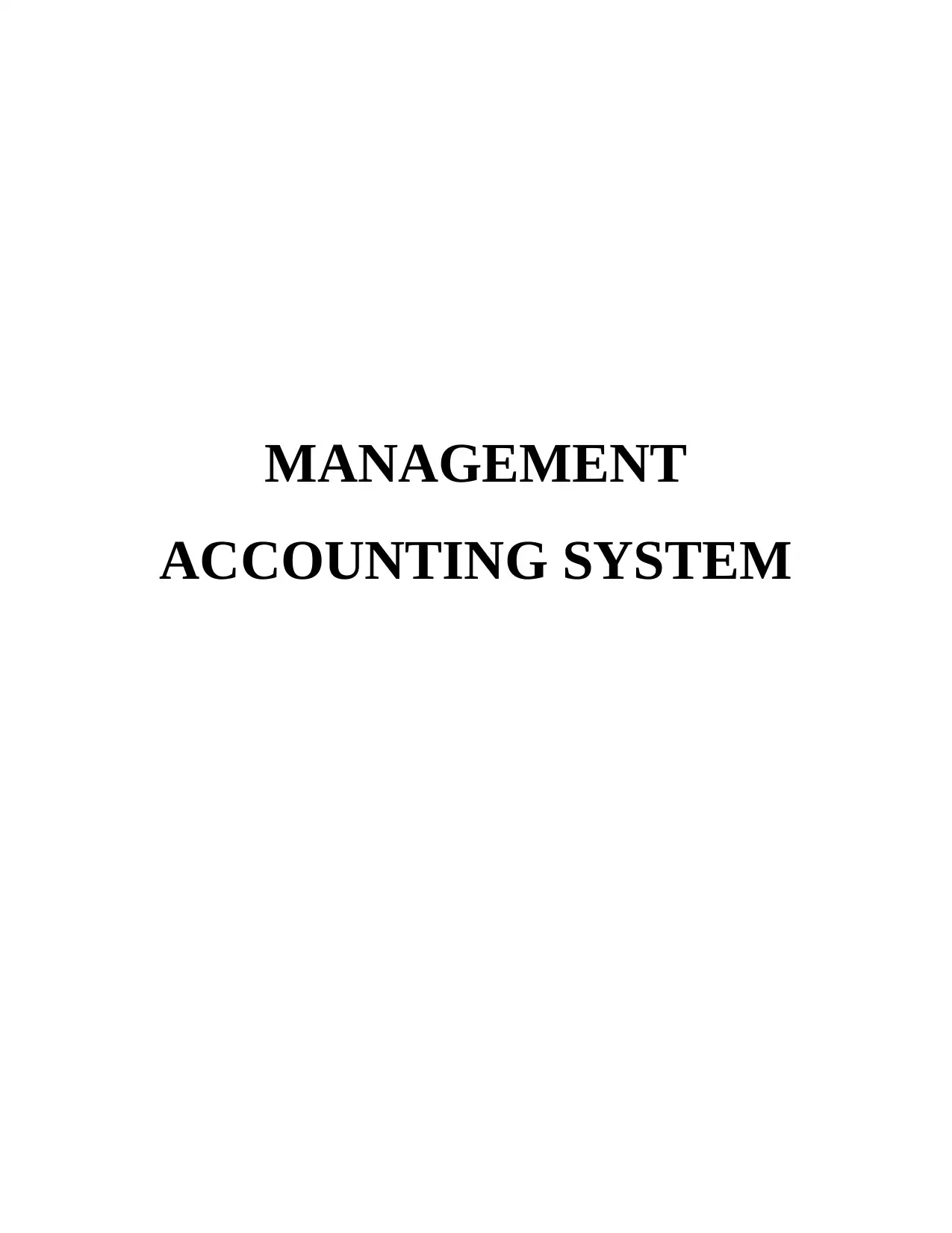
MANAGEMENT
ACCOUNTING SYSTEM
ACCOUNTING SYSTEM
Paraphrase This Document
Need a fresh take? Get an instant paraphrase of this document with our AI Paraphraser
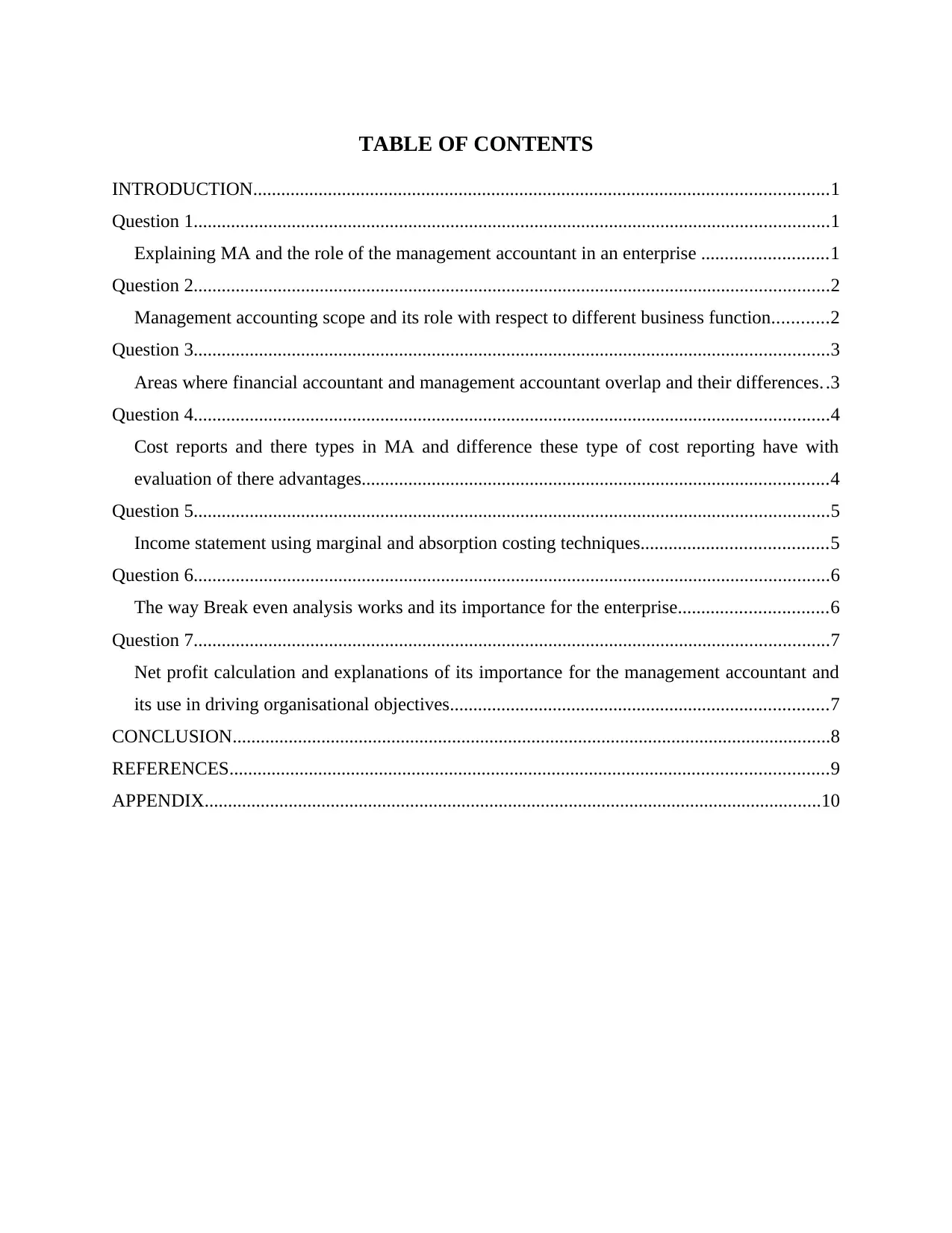
TABLE OF CONTENTS
INTRODUCTION...........................................................................................................................1
Question 1........................................................................................................................................1
Explaining MA and the role of the management accountant in an enterprise ...........................1
Question 2........................................................................................................................................2
Management accounting scope and its role with respect to different business function............2
Question 3........................................................................................................................................3
Areas where financial accountant and management accountant overlap and their differences..3
Question 4........................................................................................................................................4
Cost reports and there types in MA and difference these type of cost reporting have with
evaluation of there advantages....................................................................................................4
Question 5........................................................................................................................................5
Income statement using marginal and absorption costing techniques........................................5
Question 6........................................................................................................................................6
The way Break even analysis works and its importance for the enterprise................................6
Question 7........................................................................................................................................7
Net profit calculation and explanations of its importance for the management accountant and
its use in driving organisational objectives.................................................................................7
CONCLUSION................................................................................................................................8
REFERENCES................................................................................................................................9
APPENDIX....................................................................................................................................10
INTRODUCTION...........................................................................................................................1
Question 1........................................................................................................................................1
Explaining MA and the role of the management accountant in an enterprise ...........................1
Question 2........................................................................................................................................2
Management accounting scope and its role with respect to different business function............2
Question 3........................................................................................................................................3
Areas where financial accountant and management accountant overlap and their differences..3
Question 4........................................................................................................................................4
Cost reports and there types in MA and difference these type of cost reporting have with
evaluation of there advantages....................................................................................................4
Question 5........................................................................................................................................5
Income statement using marginal and absorption costing techniques........................................5
Question 6........................................................................................................................................6
The way Break even analysis works and its importance for the enterprise................................6
Question 7........................................................................................................................................7
Net profit calculation and explanations of its importance for the management accountant and
its use in driving organisational objectives.................................................................................7
CONCLUSION................................................................................................................................8
REFERENCES................................................................................................................................9
APPENDIX....................................................................................................................................10
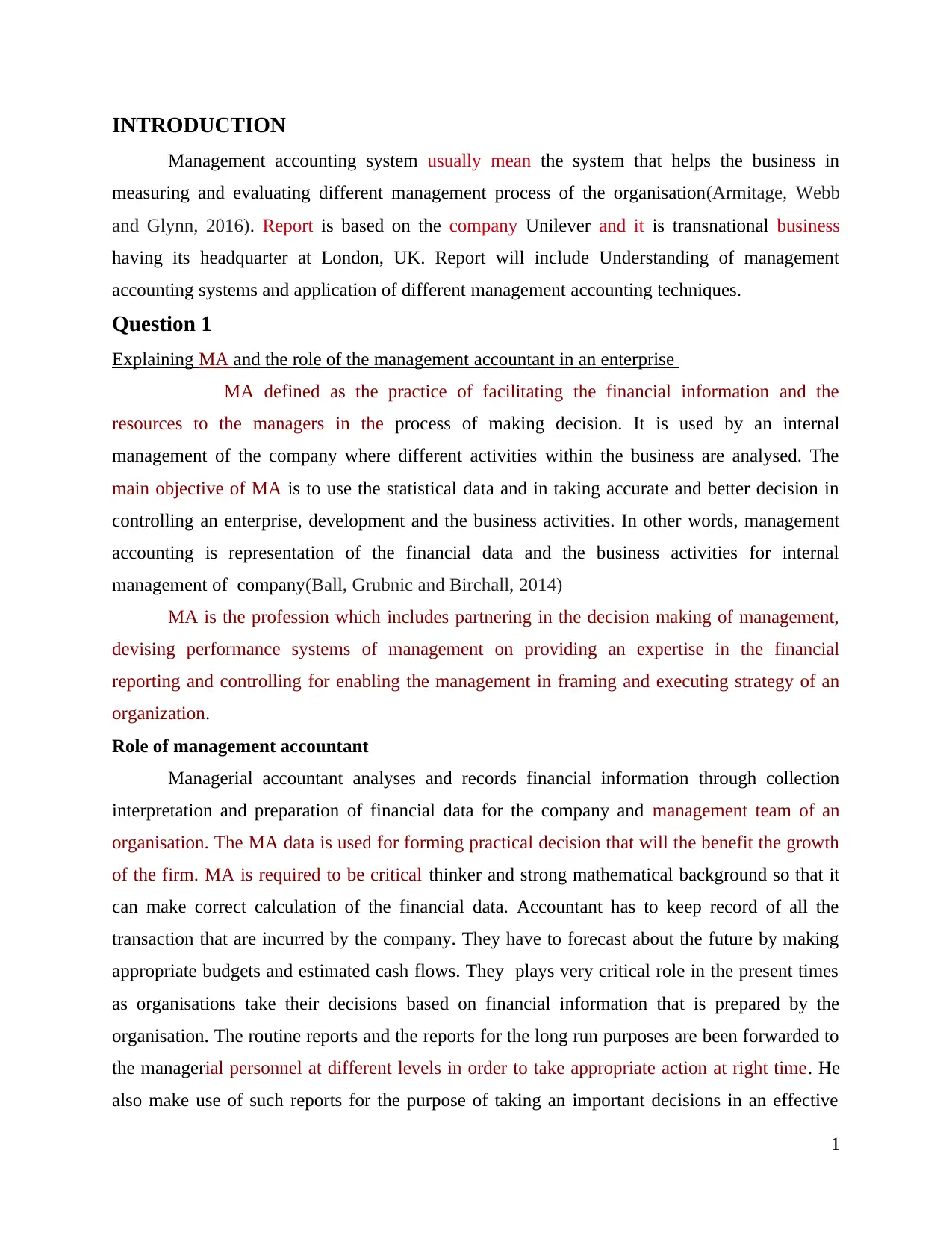
INTRODUCTION
Management accounting system usually mean the system that helps the business in
measuring and evaluating different management process of the organisation(Armitage, Webb
and Glynn, 2016). Report is based on the company Unilever and it is transnational business
having its headquarter at London, UK. Report will include Understanding of management
accounting systems and application of different management accounting techniques.
Question 1
Explaining MA and the role of the management accountant in an enterprise
MA defined as the practice of facilitating the financial information and the
resources to the managers in the process of making decision. It is used by an internal
management of the company where different activities within the business are analysed. The
main objective of MA is to use the statistical data and in taking accurate and better decision in
controlling an enterprise, development and the business activities. In other words, management
accounting is representation of the financial data and the business activities for internal
management of company(Ball, Grubnic and Birchall, 2014)
MA is the profession which includes partnering in the decision making of management,
devising performance systems of management on providing an expertise in the financial
reporting and controlling for enabling the management in framing and executing strategy of an
organization.
Role of management accountant
Managerial accountant analyses and records financial information through collection
interpretation and preparation of financial data for the company and management team of an
organisation. The MA data is used for forming practical decision that will the benefit the growth
of the firm. MA is required to be critical thinker and strong mathematical background so that it
can make correct calculation of the financial data. Accountant has to keep record of all the
transaction that are incurred by the company. They have to forecast about the future by making
appropriate budgets and estimated cash flows. They plays very critical role in the present times
as organisations take their decisions based on financial information that is prepared by the
organisation. The routine reports and the reports for the long run purposes are been forwarded to
the managerial personnel at different levels in order to take appropriate action at right time. He
also make use of such reports for the purpose of taking an important decisions in an effective
1
Management accounting system usually mean the system that helps the business in
measuring and evaluating different management process of the organisation(Armitage, Webb
and Glynn, 2016). Report is based on the company Unilever and it is transnational business
having its headquarter at London, UK. Report will include Understanding of management
accounting systems and application of different management accounting techniques.
Question 1
Explaining MA and the role of the management accountant in an enterprise
MA defined as the practice of facilitating the financial information and the
resources to the managers in the process of making decision. It is used by an internal
management of the company where different activities within the business are analysed. The
main objective of MA is to use the statistical data and in taking accurate and better decision in
controlling an enterprise, development and the business activities. In other words, management
accounting is representation of the financial data and the business activities for internal
management of company(Ball, Grubnic and Birchall, 2014)
MA is the profession which includes partnering in the decision making of management,
devising performance systems of management on providing an expertise in the financial
reporting and controlling for enabling the management in framing and executing strategy of an
organization.
Role of management accountant
Managerial accountant analyses and records financial information through collection
interpretation and preparation of financial data for the company and management team of an
organisation. The MA data is used for forming practical decision that will the benefit the growth
of the firm. MA is required to be critical thinker and strong mathematical background so that it
can make correct calculation of the financial data. Accountant has to keep record of all the
transaction that are incurred by the company. They have to forecast about the future by making
appropriate budgets and estimated cash flows. They plays very critical role in the present times
as organisations take their decisions based on financial information that is prepared by the
organisation. The routine reports and the reports for the long run purposes are been forwarded to
the managerial personnel at different levels in order to take appropriate action at right time. He
also make use of such reports for the purpose of taking an important decisions in an effective
1
⊘ This is a preview!⊘
Do you want full access?
Subscribe today to unlock all pages.

Trusted by 1+ million students worldwide
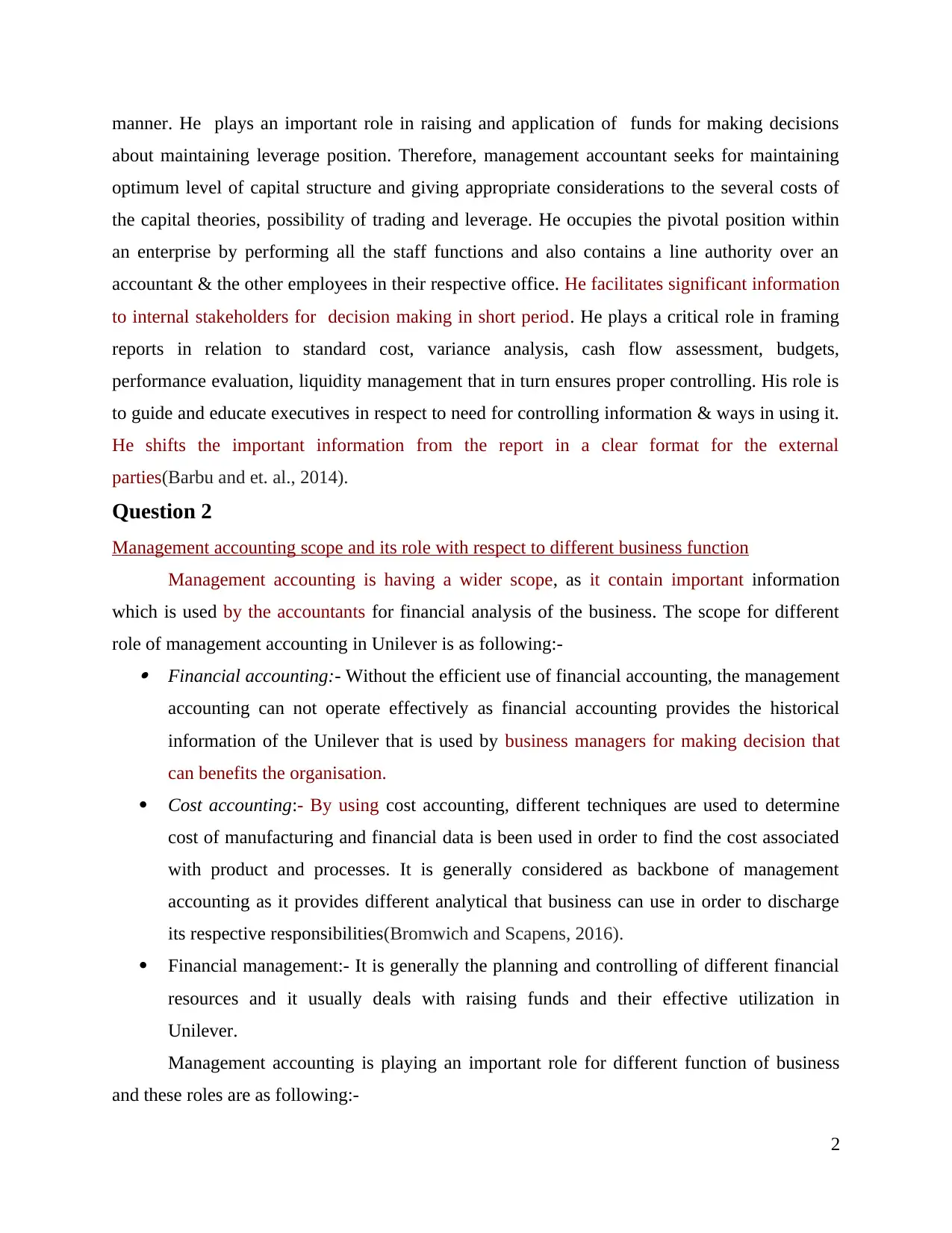
manner. He plays an important role in raising and application of funds for making decisions
about maintaining leverage position. Therefore, management accountant seeks for maintaining
optimum level of capital structure and giving appropriate considerations to the several costs of
the capital theories, possibility of trading and leverage. He occupies the pivotal position within
an enterprise by performing all the staff functions and also contains a line authority over an
accountant & the other employees in their respective office. He facilitates significant information
to internal stakeholders for decision making in short period. He plays a critical role in framing
reports in relation to standard cost, variance analysis, cash flow assessment, budgets,
performance evaluation, liquidity management that in turn ensures proper controlling. His role is
to guide and educate executives in respect to need for controlling information & ways in using it.
He shifts the important information from the report in a clear format for the external
parties(Barbu and et. al., 2014).
Question 2
Management accounting scope and its role with respect to different business function
Management accounting is having a wider scope, as it contain important information
which is used by the accountants for financial analysis of the business. The scope for different
role of management accounting in Unilever is as following:- Financial accounting:- Without the efficient use of financial accounting, the management
accounting can not operate effectively as financial accounting provides the historical
information of the Unilever that is used by business managers for making decision that
can benefits the organisation.
Cost accounting:- By using cost accounting, different techniques are used to determine
cost of manufacturing and financial data is been used in order to find the cost associated
with product and processes. It is generally considered as backbone of management
accounting as it provides different analytical that business can use in order to discharge
its respective responsibilities(Bromwich and Scapens, 2016).
Financial management:- It is generally the planning and controlling of different financial
resources and it usually deals with raising funds and their effective utilization in
Unilever.
Management accounting is playing an important role for different function of business
and these roles are as following:-
2
about maintaining leverage position. Therefore, management accountant seeks for maintaining
optimum level of capital structure and giving appropriate considerations to the several costs of
the capital theories, possibility of trading and leverage. He occupies the pivotal position within
an enterprise by performing all the staff functions and also contains a line authority over an
accountant & the other employees in their respective office. He facilitates significant information
to internal stakeholders for decision making in short period. He plays a critical role in framing
reports in relation to standard cost, variance analysis, cash flow assessment, budgets,
performance evaluation, liquidity management that in turn ensures proper controlling. His role is
to guide and educate executives in respect to need for controlling information & ways in using it.
He shifts the important information from the report in a clear format for the external
parties(Barbu and et. al., 2014).
Question 2
Management accounting scope and its role with respect to different business function
Management accounting is having a wider scope, as it contain important information
which is used by the accountants for financial analysis of the business. The scope for different
role of management accounting in Unilever is as following:- Financial accounting:- Without the efficient use of financial accounting, the management
accounting can not operate effectively as financial accounting provides the historical
information of the Unilever that is used by business managers for making decision that
can benefits the organisation.
Cost accounting:- By using cost accounting, different techniques are used to determine
cost of manufacturing and financial data is been used in order to find the cost associated
with product and processes. It is generally considered as backbone of management
accounting as it provides different analytical that business can use in order to discharge
its respective responsibilities(Bromwich and Scapens, 2016).
Financial management:- It is generally the planning and controlling of different financial
resources and it usually deals with raising funds and their effective utilization in
Unilever.
Management accounting is playing an important role for different function of business
and these roles are as following:-
2
Paraphrase This Document
Need a fresh take? Get an instant paraphrase of this document with our AI Paraphraser
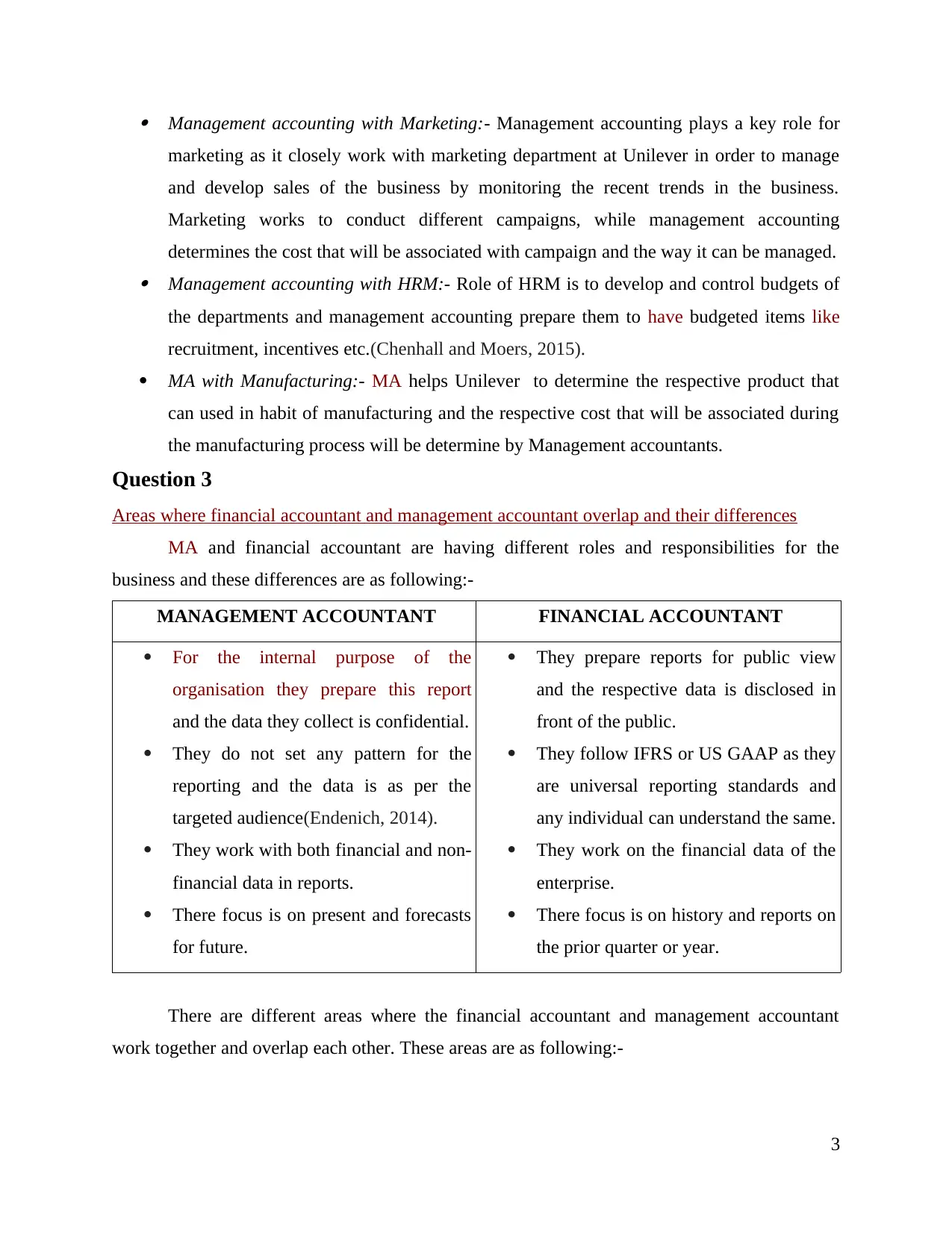
Management accounting with Marketing:- Management accounting plays a key role for
marketing as it closely work with marketing department at Unilever in order to manage
and develop sales of the business by monitoring the recent trends in the business.
Marketing works to conduct different campaigns, while management accounting
determines the cost that will be associated with campaign and the way it can be managed. Management accounting with HRM:- Role of HRM is to develop and control budgets of
the departments and management accounting prepare them to have budgeted items like
recruitment, incentives etc.(Chenhall and Moers, 2015).
MA with Manufacturing:- MA helps Unilever to determine the respective product that
can used in habit of manufacturing and the respective cost that will be associated during
the manufacturing process will be determine by Management accountants.
Question 3
Areas where financial accountant and management accountant overlap and their differences
MA and financial accountant are having different roles and responsibilities for the
business and these differences are as following:-
MANAGEMENT ACCOUNTANT FINANCIAL ACCOUNTANT
For the internal purpose of the
organisation they prepare this report
and the data they collect is confidential.
They do not set any pattern for the
reporting and the data is as per the
targeted audience(Endenich, 2014).
They work with both financial and non-
financial data in reports.
There focus is on present and forecasts
for future.
They prepare reports for public view
and the respective data is disclosed in
front of the public.
They follow IFRS or US GAAP as they
are universal reporting standards and
any individual can understand the same.
They work on the financial data of the
enterprise.
There focus is on history and reports on
the prior quarter or year.
There are different areas where the financial accountant and management accountant
work together and overlap each other. These areas are as following:-
3
marketing as it closely work with marketing department at Unilever in order to manage
and develop sales of the business by monitoring the recent trends in the business.
Marketing works to conduct different campaigns, while management accounting
determines the cost that will be associated with campaign and the way it can be managed. Management accounting with HRM:- Role of HRM is to develop and control budgets of
the departments and management accounting prepare them to have budgeted items like
recruitment, incentives etc.(Chenhall and Moers, 2015).
MA with Manufacturing:- MA helps Unilever to determine the respective product that
can used in habit of manufacturing and the respective cost that will be associated during
the manufacturing process will be determine by Management accountants.
Question 3
Areas where financial accountant and management accountant overlap and their differences
MA and financial accountant are having different roles and responsibilities for the
business and these differences are as following:-
MANAGEMENT ACCOUNTANT FINANCIAL ACCOUNTANT
For the internal purpose of the
organisation they prepare this report
and the data they collect is confidential.
They do not set any pattern for the
reporting and the data is as per the
targeted audience(Endenich, 2014).
They work with both financial and non-
financial data in reports.
There focus is on present and forecasts
for future.
They prepare reports for public view
and the respective data is disclosed in
front of the public.
They follow IFRS or US GAAP as they
are universal reporting standards and
any individual can understand the same.
They work on the financial data of the
enterprise.
There focus is on history and reports on
the prior quarter or year.
There are different areas where the financial accountant and management accountant
work together and overlap each other. These areas are as following:-
3
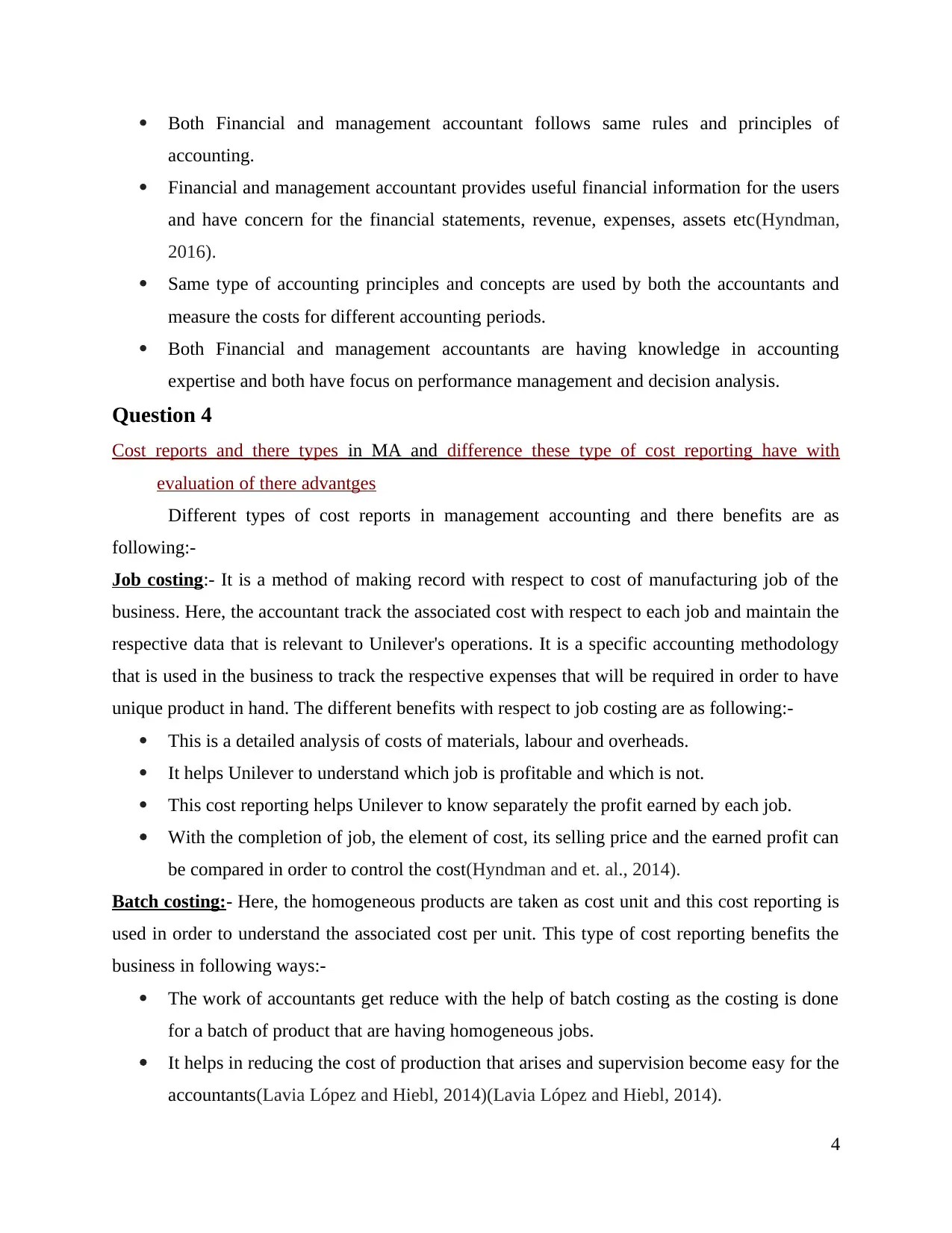
Both Financial and management accountant follows same rules and principles of
accounting.
Financial and management accountant provides useful financial information for the users
and have concern for the financial statements, revenue, expenses, assets etc(Hyndman,
2016).
Same type of accounting principles and concepts are used by both the accountants and
measure the costs for different accounting periods.
Both Financial and management accountants are having knowledge in accounting
expertise and both have focus on performance management and decision analysis.
Question 4
Cost reports and there types in MA and difference these type of cost reporting have with
evaluation of there advantges
Different types of cost reports in management accounting and there benefits are as
following:-
Job costing:- It is a method of making record with respect to cost of manufacturing job of the
business. Here, the accountant track the associated cost with respect to each job and maintain the
respective data that is relevant to Unilever's operations. It is a specific accounting methodology
that is used in the business to track the respective expenses that will be required in order to have
unique product in hand. The different benefits with respect to job costing are as following:-
This is a detailed analysis of costs of materials, labour and overheads.
It helps Unilever to understand which job is profitable and which is not.
This cost reporting helps Unilever to know separately the profit earned by each job.
With the completion of job, the element of cost, its selling price and the earned profit can
be compared in order to control the cost(Hyndman and et. al., 2014).
Batch costing:- Here, the homogeneous products are taken as cost unit and this cost reporting is
used in order to understand the associated cost per unit. This type of cost reporting benefits the
business in following ways:-
The work of accountants get reduce with the help of batch costing as the costing is done
for a batch of product that are having homogeneous jobs.
It helps in reducing the cost of production that arises and supervision become easy for the
accountants(Lavia López and Hiebl, 2014)(Lavia López and Hiebl, 2014).
4
accounting.
Financial and management accountant provides useful financial information for the users
and have concern for the financial statements, revenue, expenses, assets etc(Hyndman,
2016).
Same type of accounting principles and concepts are used by both the accountants and
measure the costs for different accounting periods.
Both Financial and management accountants are having knowledge in accounting
expertise and both have focus on performance management and decision analysis.
Question 4
Cost reports and there types in MA and difference these type of cost reporting have with
evaluation of there advantges
Different types of cost reports in management accounting and there benefits are as
following:-
Job costing:- It is a method of making record with respect to cost of manufacturing job of the
business. Here, the accountant track the associated cost with respect to each job and maintain the
respective data that is relevant to Unilever's operations. It is a specific accounting methodology
that is used in the business to track the respective expenses that will be required in order to have
unique product in hand. The different benefits with respect to job costing are as following:-
This is a detailed analysis of costs of materials, labour and overheads.
It helps Unilever to understand which job is profitable and which is not.
This cost reporting helps Unilever to know separately the profit earned by each job.
With the completion of job, the element of cost, its selling price and the earned profit can
be compared in order to control the cost(Hyndman and et. al., 2014).
Batch costing:- Here, the homogeneous products are taken as cost unit and this cost reporting is
used in order to understand the associated cost per unit. This type of cost reporting benefits the
business in following ways:-
The work of accountants get reduce with the help of batch costing as the costing is done
for a batch of product that are having homogeneous jobs.
It helps in reducing the cost of production that arises and supervision become easy for the
accountants(Lavia López and Hiebl, 2014)(Lavia López and Hiebl, 2014).
4
⊘ This is a preview!⊘
Do you want full access?
Subscribe today to unlock all pages.

Trusted by 1+ million students worldwide
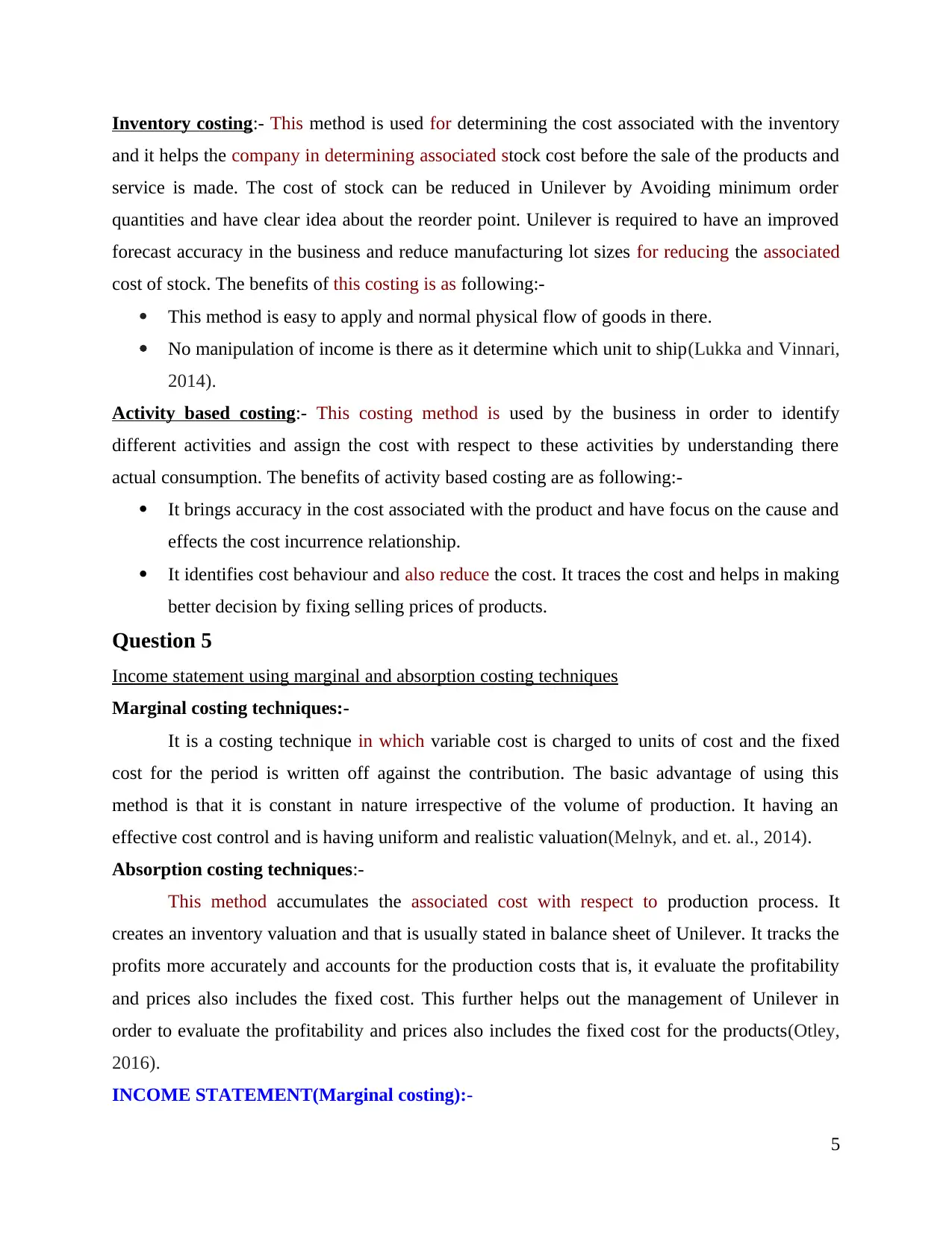
Inventory costing:- This method is used for determining the cost associated with the inventory
and it helps the company in determining associated stock cost before the sale of the products and
service is made. The cost of stock can be reduced in Unilever by Avoiding minimum order
quantities and have clear idea about the reorder point. Unilever is required to have an improved
forecast accuracy in the business and reduce manufacturing lot sizes for reducing the associated
cost of stock. The benefits of this costing is as following:-
This method is easy to apply and normal physical flow of goods in there.
No manipulation of income is there as it determine which unit to ship(Lukka and Vinnari,
2014).
Activity based costing:- This costing method is used by the business in order to identify
different activities and assign the cost with respect to these activities by understanding there
actual consumption. The benefits of activity based costing are as following:-
It brings accuracy in the cost associated with the product and have focus on the cause and
effects the cost incurrence relationship.
It identifies cost behaviour and also reduce the cost. It traces the cost and helps in making
better decision by fixing selling prices of products.
Question 5
Income statement using marginal and absorption costing techniques
Marginal costing techniques:-
It is a costing technique in which variable cost is charged to units of cost and the fixed
cost for the period is written off against the contribution. The basic advantage of using this
method is that it is constant in nature irrespective of the volume of production. It having an
effective cost control and is having uniform and realistic valuation(Melnyk, and et. al., 2014).
Absorption costing techniques:-
This method accumulates the associated cost with respect to production process. It
creates an inventory valuation and that is usually stated in balance sheet of Unilever. It tracks the
profits more accurately and accounts for the production costs that is, it evaluate the profitability
and prices also includes the fixed cost. This further helps out the management of Unilever in
order to evaluate the profitability and prices also includes the fixed cost for the products(Otley,
2016).
INCOME STATEMENT(Marginal costing):-
5
and it helps the company in determining associated stock cost before the sale of the products and
service is made. The cost of stock can be reduced in Unilever by Avoiding minimum order
quantities and have clear idea about the reorder point. Unilever is required to have an improved
forecast accuracy in the business and reduce manufacturing lot sizes for reducing the associated
cost of stock. The benefits of this costing is as following:-
This method is easy to apply and normal physical flow of goods in there.
No manipulation of income is there as it determine which unit to ship(Lukka and Vinnari,
2014).
Activity based costing:- This costing method is used by the business in order to identify
different activities and assign the cost with respect to these activities by understanding there
actual consumption. The benefits of activity based costing are as following:-
It brings accuracy in the cost associated with the product and have focus on the cause and
effects the cost incurrence relationship.
It identifies cost behaviour and also reduce the cost. It traces the cost and helps in making
better decision by fixing selling prices of products.
Question 5
Income statement using marginal and absorption costing techniques
Marginal costing techniques:-
It is a costing technique in which variable cost is charged to units of cost and the fixed
cost for the period is written off against the contribution. The basic advantage of using this
method is that it is constant in nature irrespective of the volume of production. It having an
effective cost control and is having uniform and realistic valuation(Melnyk, and et. al., 2014).
Absorption costing techniques:-
This method accumulates the associated cost with respect to production process. It
creates an inventory valuation and that is usually stated in balance sheet of Unilever. It tracks the
profits more accurately and accounts for the production costs that is, it evaluate the profitability
and prices also includes the fixed cost. This further helps out the management of Unilever in
order to evaluate the profitability and prices also includes the fixed cost for the products(Otley,
2016).
INCOME STATEMENT(Marginal costing):-
5
Paraphrase This Document
Need a fresh take? Get an instant paraphrase of this document with our AI Paraphraser
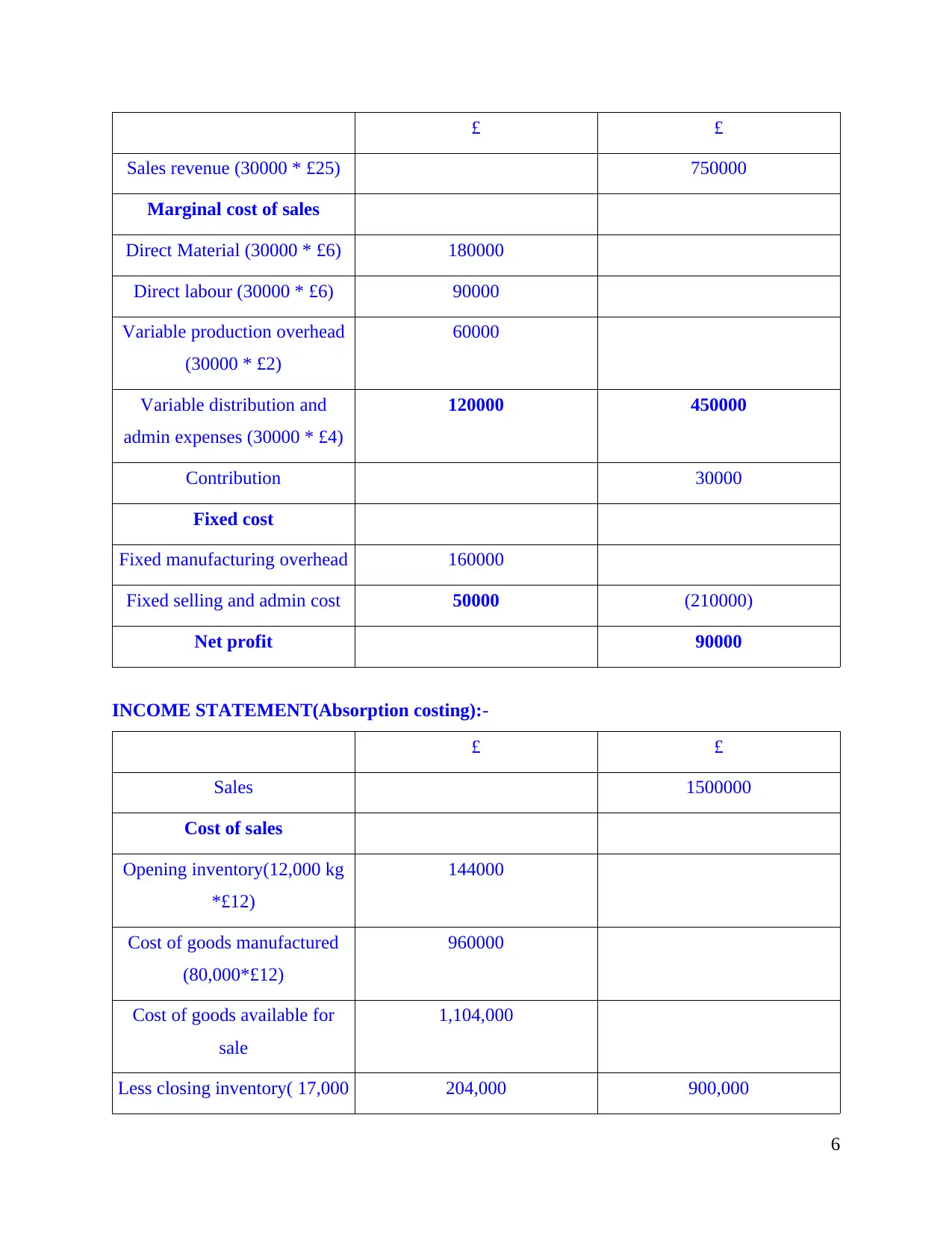
£ £
Sales revenue (30000 * £25) 750000
Marginal cost of sales
Direct Material (30000 * £6) 180000
Direct labour (30000 * £6) 90000
Variable production overhead
(30000 * £2)
60000
Variable distribution and
admin expenses (30000 * £4)
120000 450000
Contribution 30000
Fixed cost
Fixed manufacturing overhead 160000
Fixed selling and admin cost 50000 (210000)
Net profit 90000
INCOME STATEMENT(Absorption costing):-
£ £
Sales 1500000
Cost of sales
Opening inventory(12,000 kg
*£12)
144000
Cost of goods manufactured
(80,000*£12)
960000
Cost of goods available for
sale
1,104,000
Less closing inventory( 17,000 204,000 900,000
6
Sales revenue (30000 * £25) 750000
Marginal cost of sales
Direct Material (30000 * £6) 180000
Direct labour (30000 * £6) 90000
Variable production overhead
(30000 * £2)
60000
Variable distribution and
admin expenses (30000 * £4)
120000 450000
Contribution 30000
Fixed cost
Fixed manufacturing overhead 160000
Fixed selling and admin cost 50000 (210000)
Net profit 90000
INCOME STATEMENT(Absorption costing):-
£ £
Sales 1500000
Cost of sales
Opening inventory(12,000 kg
*£12)
144000
Cost of goods manufactured
(80,000*£12)
960000
Cost of goods available for
sale
1,104,000
Less closing inventory( 17,000 204,000 900,000
6
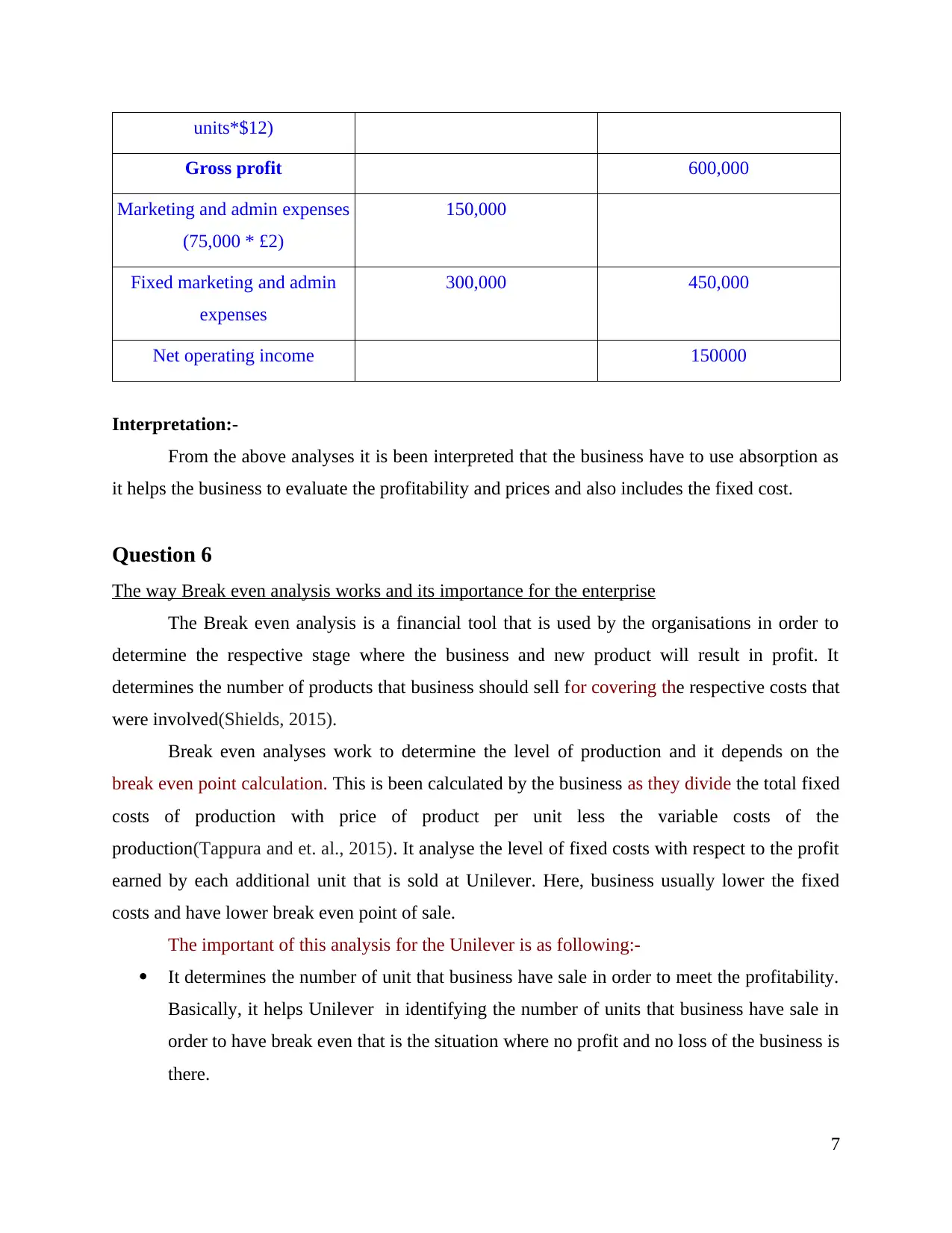
units*$12)
Gross profit 600,000
Marketing and admin expenses
(75,000 * £2)
150,000
Fixed marketing and admin
expenses
300,000 450,000
Net operating income 150000
Interpretation:-
From the above analyses it is been interpreted that the business have to use absorption as
it helps the business to evaluate the profitability and prices and also includes the fixed cost.
Question 6
The way Break even analysis works and its importance for the enterprise
The Break even analysis is a financial tool that is used by the organisations in order to
determine the respective stage where the business and new product will result in profit. It
determines the number of products that business should sell for covering the respective costs that
were involved(Shields, 2015).
Break even analyses work to determine the level of production and it depends on the
break even point calculation. This is been calculated by the business as they divide the total fixed
costs of production with price of product per unit less the variable costs of the
production(Tappura and et. al., 2015). It analyse the level of fixed costs with respect to the profit
earned by each additional unit that is sold at Unilever. Here, business usually lower the fixed
costs and have lower break even point of sale.
The important of this analysis for the Unilever is as following:-
It determines the number of unit that business have sale in order to meet the profitability.
Basically, it helps Unilever in identifying the number of units that business have sale in
order to have break even that is the situation where no profit and no loss of the business is
there.
7
Gross profit 600,000
Marketing and admin expenses
(75,000 * £2)
150,000
Fixed marketing and admin
expenses
300,000 450,000
Net operating income 150000
Interpretation:-
From the above analyses it is been interpreted that the business have to use absorption as
it helps the business to evaluate the profitability and prices and also includes the fixed cost.
Question 6
The way Break even analysis works and its importance for the enterprise
The Break even analysis is a financial tool that is used by the organisations in order to
determine the respective stage where the business and new product will result in profit. It
determines the number of products that business should sell for covering the respective costs that
were involved(Shields, 2015).
Break even analyses work to determine the level of production and it depends on the
break even point calculation. This is been calculated by the business as they divide the total fixed
costs of production with price of product per unit less the variable costs of the
production(Tappura and et. al., 2015). It analyse the level of fixed costs with respect to the profit
earned by each additional unit that is sold at Unilever. Here, business usually lower the fixed
costs and have lower break even point of sale.
The important of this analysis for the Unilever is as following:-
It determines the number of unit that business have sale in order to meet the profitability.
Basically, it helps Unilever in identifying the number of units that business have sale in
order to have break even that is the situation where no profit and no loss of the business is
there.
7
⊘ This is a preview!⊘
Do you want full access?
Subscribe today to unlock all pages.

Trusted by 1+ million students worldwide
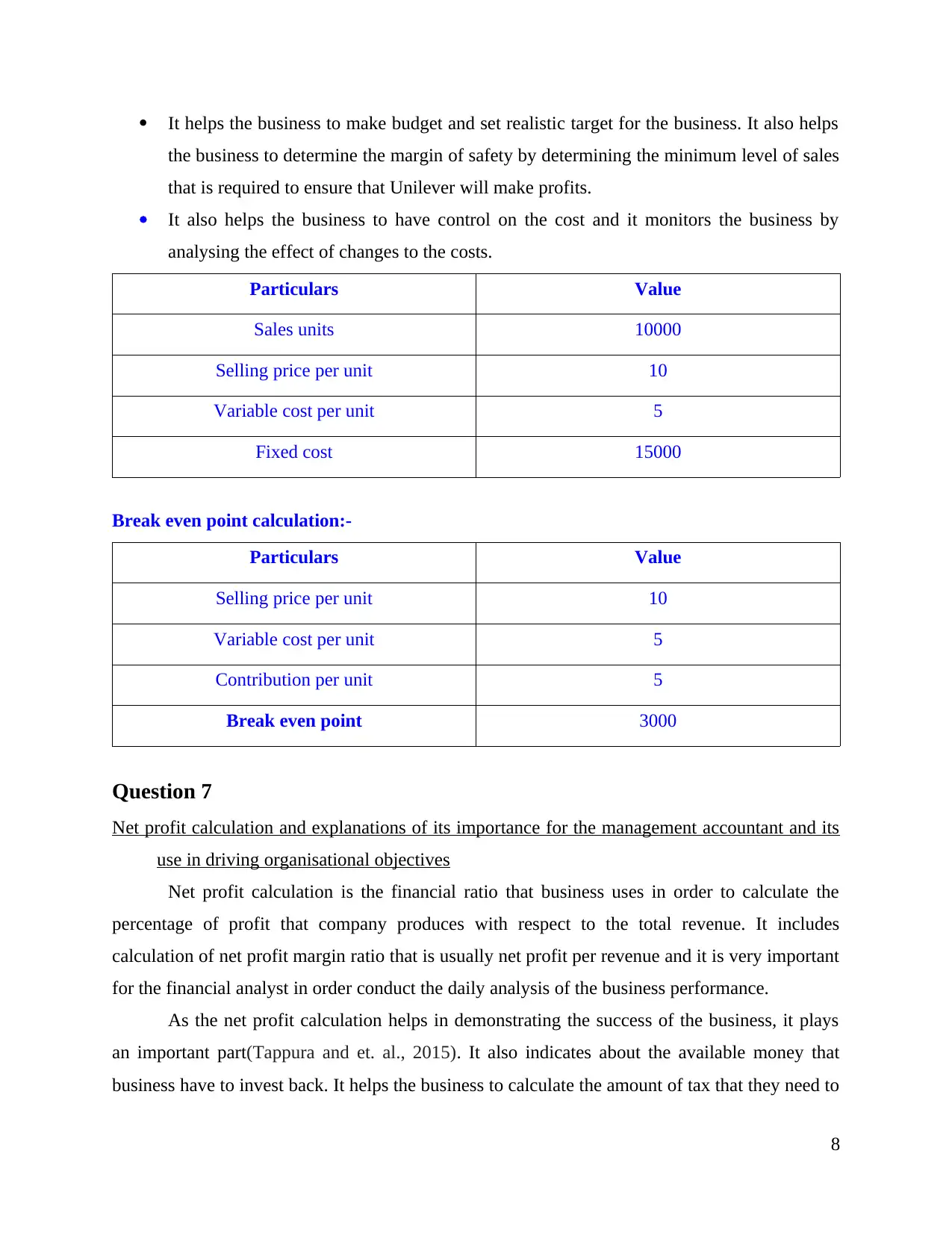
It helps the business to make budget and set realistic target for the business. It also helps
the business to determine the margin of safety by determining the minimum level of sales
that is required to ensure that Unilever will make profits.
It also helps the business to have control on the cost and it monitors the business by
analysing the effect of changes to the costs.
Particulars Value
Sales units 10000
Selling price per unit 10
Variable cost per unit 5
Fixed cost 15000
Break even point calculation:-
Particulars Value
Selling price per unit 10
Variable cost per unit 5
Contribution per unit 5
Break even point 3000
Question 7
Net profit calculation and explanations of its importance for the management accountant and its
use in driving organisational objectives
Net profit calculation is the financial ratio that business uses in order to calculate the
percentage of profit that company produces with respect to the total revenue. It includes
calculation of net profit margin ratio that is usually net profit per revenue and it is very important
for the financial analyst in order conduct the daily analysis of the business performance.
As the net profit calculation helps in demonstrating the success of the business, it plays
an important part(Tappura and et. al., 2015). It also indicates about the available money that
business have to invest back. It helps the business to calculate the amount of tax that they need to
8
the business to determine the margin of safety by determining the minimum level of sales
that is required to ensure that Unilever will make profits.
It also helps the business to have control on the cost and it monitors the business by
analysing the effect of changes to the costs.
Particulars Value
Sales units 10000
Selling price per unit 10
Variable cost per unit 5
Fixed cost 15000
Break even point calculation:-
Particulars Value
Selling price per unit 10
Variable cost per unit 5
Contribution per unit 5
Break even point 3000
Question 7
Net profit calculation and explanations of its importance for the management accountant and its
use in driving organisational objectives
Net profit calculation is the financial ratio that business uses in order to calculate the
percentage of profit that company produces with respect to the total revenue. It includes
calculation of net profit margin ratio that is usually net profit per revenue and it is very important
for the financial analyst in order conduct the daily analysis of the business performance.
As the net profit calculation helps in demonstrating the success of the business, it plays
an important part(Tappura and et. al., 2015). It also indicates about the available money that
business have to invest back. It helps the business to calculate the amount of tax that they need to
8
Paraphrase This Document
Need a fresh take? Get an instant paraphrase of this document with our AI Paraphraser
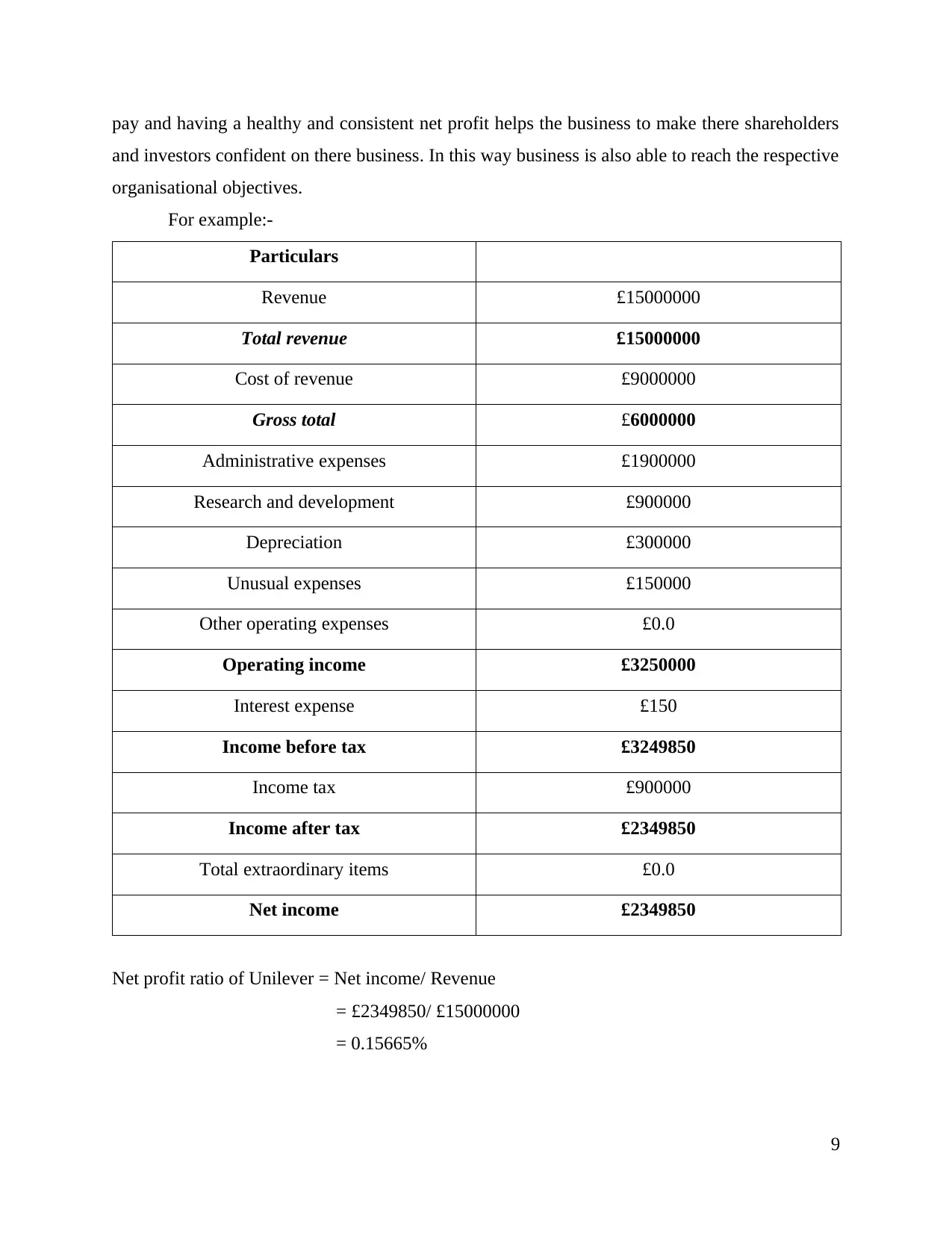
pay and having a healthy and consistent net profit helps the business to make there shareholders
and investors confident on there business. In this way business is also able to reach the respective
organisational objectives.
For example:-
Particulars
Revenue £15000000
Total revenue £15000000
Cost of revenue £9000000
Gross total £6000000
Administrative expenses £1900000
Research and development £900000
Depreciation £300000
Unusual expenses £150000
Other operating expenses £0.0
Operating income £3250000
Interest expense £150
Income before tax £3249850
Income tax £900000
Income after tax £2349850
Total extraordinary items £0.0
Net income £2349850
Net profit ratio of Unilever = Net income/ Revenue
= £2349850/ £15000000
= 0.15665%
9
and investors confident on there business. In this way business is also able to reach the respective
organisational objectives.
For example:-
Particulars
Revenue £15000000
Total revenue £15000000
Cost of revenue £9000000
Gross total £6000000
Administrative expenses £1900000
Research and development £900000
Depreciation £300000
Unusual expenses £150000
Other operating expenses £0.0
Operating income £3250000
Interest expense £150
Income before tax £3249850
Income tax £900000
Income after tax £2349850
Total extraordinary items £0.0
Net income £2349850
Net profit ratio of Unilever = Net income/ Revenue
= £2349850/ £15000000
= 0.15665%
9
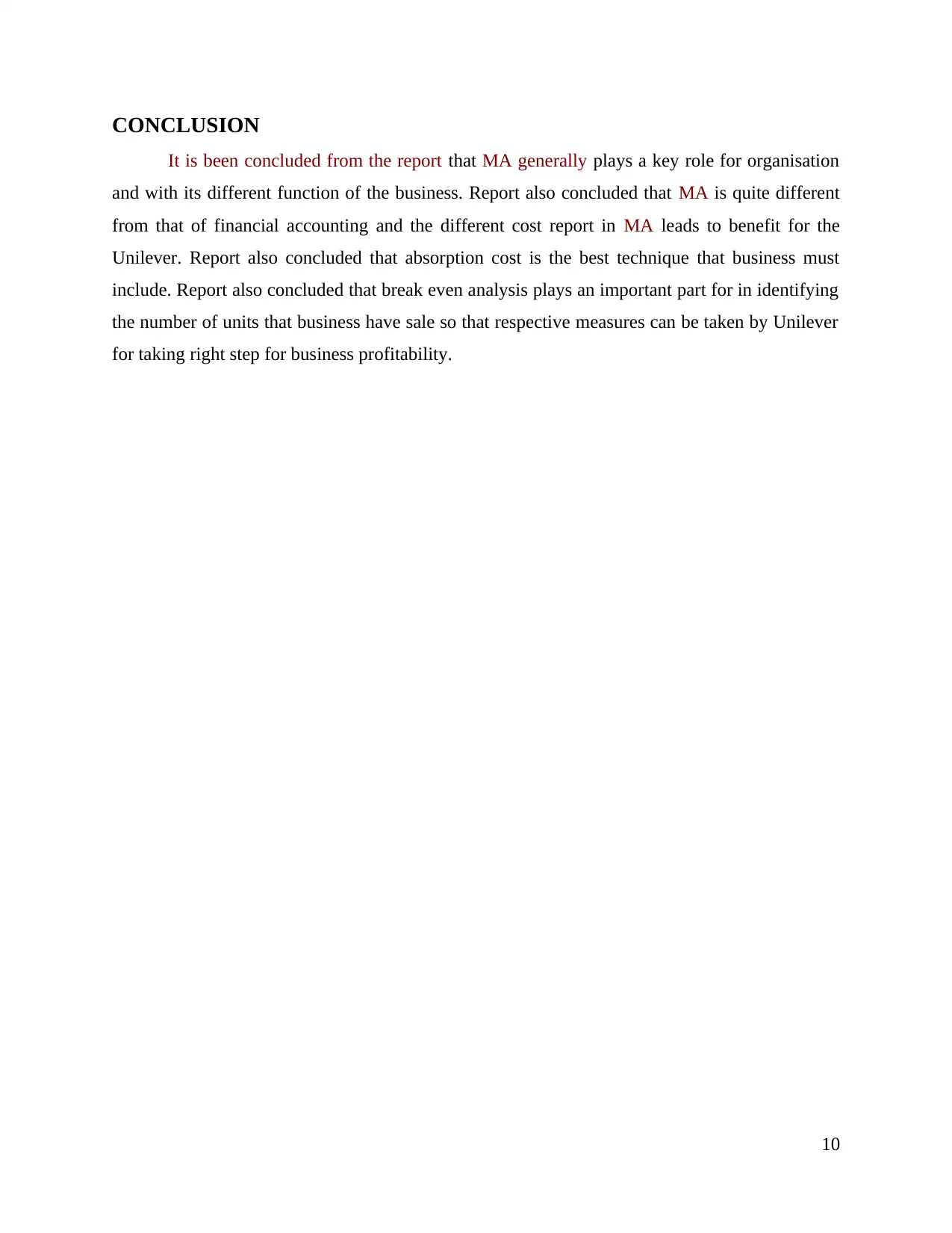
CONCLUSION
It is been concluded from the report that MA generally plays a key role for organisation
and with its different function of the business. Report also concluded that MA is quite different
from that of financial accounting and the different cost report in MA leads to benefit for the
Unilever. Report also concluded that absorption cost is the best technique that business must
include. Report also concluded that break even analysis plays an important part for in identifying
the number of units that business have sale so that respective measures can be taken by Unilever
for taking right step for business profitability.
10
It is been concluded from the report that MA generally plays a key role for organisation
and with its different function of the business. Report also concluded that MA is quite different
from that of financial accounting and the different cost report in MA leads to benefit for the
Unilever. Report also concluded that absorption cost is the best technique that business must
include. Report also concluded that break even analysis plays an important part for in identifying
the number of units that business have sale so that respective measures can be taken by Unilever
for taking right step for business profitability.
10
⊘ This is a preview!⊘
Do you want full access?
Subscribe today to unlock all pages.

Trusted by 1+ million students worldwide
1 out of 13
Related Documents
Your All-in-One AI-Powered Toolkit for Academic Success.
+13062052269
info@desklib.com
Available 24*7 on WhatsApp / Email
![[object Object]](/_next/static/media/star-bottom.7253800d.svg)
Unlock your academic potential
Copyright © 2020–2025 A2Z Services. All Rights Reserved. Developed and managed by ZUCOL.





